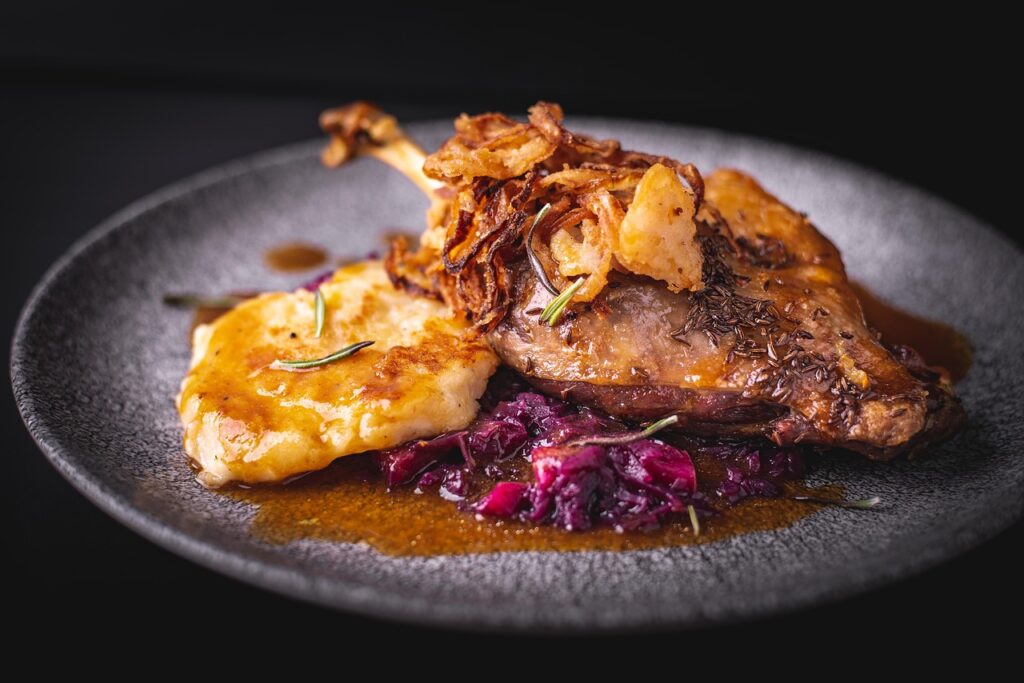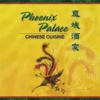Introduction on Peking Duck
Peking Duck Food isn’t just a dish—it’s an entire cultural performance brought to life on a plate. Imagine biting into thin, crispy skin that practically shatters with a delicate crunch between your teeth, followed by juicy, tender duck meat that melts in your mouth, all wrapped in a warm pancake with a generous swipe of hoisin sauce and a sprinkle of fresh scallions.

It’s the kind of combination that instantly makes you pause and savour the moment. Sounds heavenly, right? That’s the irresistible magic of Peking duck. It’s not only one of Beijing’s most iconic foods, but also a culinary creation that has been captivating taste buds and winning hearts across the globe for centuries, carrying with it stories of history, tradition, and pride.
Order Online
The Origins of Peking Duck
A Royal Beginning
The fascinating story of the Peking duck dates back to the imperial kitchens of the Yuan Dynasty, more than 700 years ago. Back then, it was considered a delicacy reserved only for emperors, aristocrats, and members of the royal court, symbolizing power, luxury, and refined taste. Imagine emperors seated in grand palaces, feasting on this golden-skinned bird while poets and scholars penned odes about its unrivalled crispness and unmatched flavour—it was highly revered. For many years, ordinary citizens could only dream of tasting such perfection.
Influence on Chinese Cuisine
As centuries passed and dynasties rose and fell, Peking duck slowly made its way from the royal tables into the daily lives of ordinary people, transforming from a luxury item into a treasured part of Chinese culture. Its influence on the development of roasted meats in China cannot be overstated. Even today, this iconic dish remains a centrepiece at grand banquets, family weddings, national celebrations, and festive gatherings, symbolizing not only abundance but also unity and joy. It is a dish that bridges generations, carrying ancient traditions into the modern dining experience.
What Makes Peking Duck Unique?
The Skin is the Star
Here, the true star is the skin—crispy, glossy, golden brown, and almost jewel-like in appearance. Chefs dedicate countless hours of labour and expertise to ensure it reaches the perfect texture: crunchy and delicate without being greasy or heavy. Every bite is carefully crafted to deliver a satisfying shatter, followed by the rich, savoury undertones of tender duck beneath.
Traditional Ingredients
What makes the dish even more remarkable is the simplicity of the ingredients used in its preparation. Instead of relying on overpowering marinades, Peking duck utilizes subtle yet powerful flavours, including star anise, ginger, maltose syrup, and occasionally a hint of cinnamon or cloves. These spices don’t scream for attention; instead, they whisper in harmony, enhancing the duck’s natural richness without overshadowing it. This balance is part of what makes the dish remain timeless and universally appealing.
The Preparation Process
Air-Drying the Duck
Here’s where the artistry really begins. This clever step ensures that the fat melts away during roasting while the skin cooks independently, becoming perfectly crisp. Once inflated, the duck is hung to dry for up to 24 hours, often brushed with maltose syrup to create that glossy finish. This painstaking process is what transforms an ordinary bird into a masterpiece.
The Hanging Oven Method
Unlike your typical oven roast, Peking duck is cooked in a unique open oven where the bird hangs gracefully over a fragrant wood fire. Traditional woods such as fruitwood are used, imparting a smoky aroma and delicate sweetness to the skin. The open-air roasting ensures that heat circulates evenly, browning the skin to perfection while sealing in the meat’s juices. The result? A golden-brown bird that glistens like lacquer and smells so inviting you can barely wait for it to be served.
Carving with Precision
The preparation doesn’t stop when the duck cooked. A skilled chef takes the stage, carving the duck into more than 100 uniform slices, each with just the right balance of crispy skin and tender meat. Watching the carving itself feels like witnessing a performance—quick, precise, and elegant. Each slice is placed with care, creating a visual presentation as stunning as the taste itself.
The Art of Serving Peking Duck
Pancakes, Sauce, and Scallions
It’s almost like building your own little wrap —a perfect bundle of flavours that combines crunch, freshness, sweetness, and softness in every bite. This DIY style of eating also adds to the fun, making each bite feel personal and satisfying.
The Three-Stage Dining Experience
But Peking duck isn’t just one dish—it’s an entire dining experience crafted in stages. First comes the crispy skin, sometimes served with sugar or garlic sauce, highlighting its unique crunch. Next, the meat served wrapped in pancakes, accompanied by all the classic accompaniments. Finally, the remaining duck bones are simmered into a rich, comforting soup, ensuring no part of the bird goes to waste. It’s a full-circle culinary journey that feels both indulgent and thoughtful.
Famous Restaurants for Peking Duck in Beijing
Quanjude Restaurant
With a history spanning over a century, it has perfected the art of this dish and continues to draw both locals and tourists who want a taste of authenticity. For many, dining at Quanjude is a pilgrimage, an essential Beijing experience.
Da Dong Roast Duck
Known for its modern twist, Da Dong has become a favourite among younger generations and international visitors. Da Dong serves up a lighter take on Peking duck, appealing to health-conscious diners while still delivering the same irresistible crispiness and rich flavor the dish known for. It’s proof that tradition can adapt and remain delicious.
Bianyifang Legacy
Bianyifang, one of the oldest Peking duck restaurants, distinguished by its use of closed ovens rather than the traditional open hanging style. This technique yields a distinct, more nuanced flavour, enabling diners to appreciate another facet of this timeless dish. It’s like tasting history with every bite.
Peking Duck Beyond China
Popularity in the United States
Walk into any major U.S. city—New York, Los Angeles, Chicago, or San Francisco—and you’ll find Peking duck proudly displayed on high-end Chinese restaurant menus. For many food enthusiasts, it’s a bucket-list dish, one that connects them instantly to the rich culture of Beijing. It has become more than just a Chinese delicacy; it’s a global culinary treasure.
Influence on Asian Fusion Cuisine
Chefs around the world have drawn inspiration from Peking duck, creating innovative dishes such as duck tacos, sliders, sushi rolls, and even pizzas topped with crispy duck skin. While purists may frown at these variations, these creative spins keep the tradition alive and introduce it to new audiences who might never have experienced it otherwise.
Cultural Significance of Peking Duck
Symbol of Status and Celebration
In China, serving Peking duck often seen as a gesture of honour, hospitality, and respect. Families order it for birthdays, business dinners, weddings, and important holidays as a way to celebrate abundance and success. It’s not just a dish—it’s an event.
A Culinary Export of Pride
For China, Peking duck is more than food; it is a culinary ambassador that represents the culture, history, and pride of Beijing. Just like sushi has become synonymous with Japan, Peking duck has become a global symbol of China’s rich culinary heritage.
How Peking Duck Differs from Other Duck Dishes
Peking Duck vs. Cantonese Roast Duck
Cantonese roast duck emphasizes juicy, flavorful meat with a strong marinade, while Peking duck prioritizes crispy skin as its crowning glory. Both are delicious, but the philosophy behind them is entirely different.
Peking Duck vs. Western-Style Roast Duck
Western roast duck often seasoned with herbs such as thyme, rosemary, and sage, which infuse it with a hearty, rustic, and earthy taste. Peking duck, however, sticks to Chinese spices and techniques, delivering a more delicate yet complex taste experience.
Modern Variations of Peking Duck Food
Health-Conscious Adaptations
As diners today become more health-conscious, many chefs are experimenting with leaner cuts of duck, lighter glazes, and reduced sugar content. These minor adjustments make the dish more accessible without compromising its core identity.
Creative Fusion Dishes
From bao buns stuffed with duck to sushi topped with crispy duck skin. Chefs are reimagining Peking duck in ways that surprise and delight. These creative twists show just how versatile and enduring this dish can be.
Tips for Enjoying Peking Duck Food
Choosing the Right Side Dishes
To balance the richness of the duck, pair it with refreshing sides such as stir-fried greens, pickled vegetables, or a light salad. These sides cut through the heaviness, creating a more balanced meal.
Pairing with Drinks
When it comes to drinks, plum wine, light beer, or even Chinese rice wine complements the sweetness of the sauce and the smoky undertones of the duck. Green tea is also an excellent choice, as it cleanses your palate and prepares you for the next delicious bite.
Conclusion
Peking duck isn’t just food—it’s a story of tradition, artistry, and flavour that has carefully passed down through centuries. Whether you’re savouring it in Beijing’s bustling streets or trying a creative fusion version at a modern restaurant abroad. One thing is sure: every bite of Peking duck is more than just a meal—it’s a bite into history itself.
FAQs
Q1: What makes Peking duck different from regular roast duck?
Unlike typical roast Peking Duck Food, which emphasizes tender meat and rich marinades. Peking duck renowned for its perfectly crisp skin and the meticulous artistry involved in its carving.
Q2: Can you make Peking duck at home?
Yes, but it’s a challenge. The process of air-drying, inflating, and roasting the duck in a hanging oven is difficult to replicate in a standard kitchen.
Q3: What sauces are best with Peking duck?
Hoisin sauce is the traditional favourite, but garlic sauce, sweet bean sauce, or even plum sauce can enhance its flavour beautifully.
Q4: Is Peking duck healthy?
It’s rich and indulgent, but leaner adaptations and smaller servings can make it a healthier option when enjoyed in moderation.
Q5: What makes Peking duck a symbol of cultural heritage?
Because it represents more than taste—it embodies centuries of Chinese history, culinary expertise, and cultural pride, making it a true global ambassador of Beijing cuisine.
